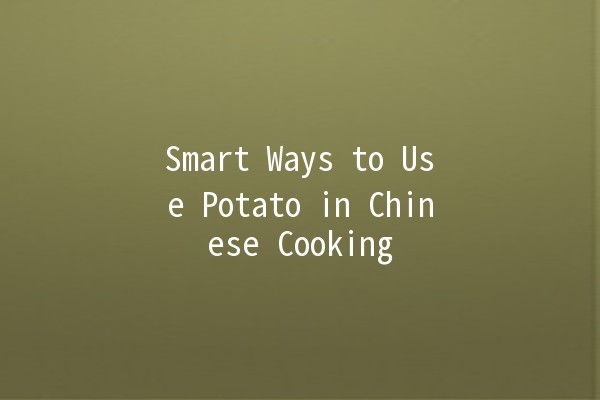In the world of Chinese cuisine, the potato is often underestimated. While it may not have the same reputation as rice or noodles, it holds a significant place and offers a variety of uses that can elevate your dishes. Here, we will delve into effective techniques for incorporating potatoes into your Chinese meals, enhancing flavor and texture, and boosting your culinary creativity.
The first step in mastering potato use is understanding the different varieties available. Depending on your dish, the type of potato can drastically influence the texture and flavor.
Yukon Gold: Known for its buttery flavor and creamy texture, this potato is excellent for stirfrying and soups. It holds its shape well and absorbs flavors beautifully.

Russet Potatoes: Ideal for mash or baked dishes, russet potatoes provide a fluffy texture. However, caution is required when using them in stirfry, as they can become too mushy.
Red Potatoes: With a waxy texture, these potatoes are perfect for boiling or steaming and maintain their shape well, making them great for salads or side dishes.
Practical Application Example:
Consider making a StirFried Potato and Green Peppers dish. Use Yukon Gold potatoes for a creamy texture that pairs well with the crunch of fresh bell peppers. Simply peel and slice the potatoes thinly, and stirfry with garlic, soy sauce, and diced peppers for a quick, flavorful side.
Potato starch is a versatile ingredient that can be used to thicken sauces and create a crispy coating for fried foods. Its neutral flavor makes it suitable for various dishes.
Using Potato Starch as a Thickener
When preparing a sauce or a soup, adding potato starch can provide a desirable thickness without altering the flavor.
Example Recipe: Try using potato starch in a Sweet and Sour Chicken dish. Mix a couple of tablespoons of potato starch with cold water to create a slurry. Add it towards the end of cooking to thicken the sauce, resulting in a lovely glossy finish.
Creating Crispy Textures
Potato starch can also be used to coat meats or vegetables before frying, ensuring a crispy outer layer.
Example Application: Coat chicken pieces in potato starch before frying to achieve a crunchy texture. This works particularly well in dishes like Salt and Pepper Chicken, where a crispy bite is essential.
Potatoes can also be an excellent addition to dumpling fillings, offering a unique twist and added moisture to the traditional minced meat or vegetable mixtures.
Recipe Idea: Potato and Pork Dumplings
Ingredients: Ground pork, mashed potatoes, green onions, ginger, soy sauce, and dumpling wrappers.
Preparation:
This combination not only enhances the flavor but also provides a smooth texture that complements the meat.
Potatoes have a natural sweetness that can balance savory flavors in many dishes. This sweetness can be highlighted through proper cooking methods.
Example: Sweet Potato and Bok Choy StirFry
Ingredients: Sweet potatoes, bok choy, garlic, and sesame oil.
Cooking Method:
This stirfry emphasizes natural sweetness, creating a delicious dish that pairs well with rice or proteins.
Beyond traditional uses, potatoes can inspire creativity and innovation in your cooking.
Trendy Recipe: Potato Noodles
Ingredients: Potatoes, salt, and your choice of sauce.
Preparation:
Potato noodles offer a glutenfree alternative to rice or wheat noodles and can absorb flavors well, making them a fantastic addition to various dishes.
Common Questions About Using Potatoes in Chinese Cooking
While many potatoes can be used for stirfrying, favorites include Yukon Gold for their creamy texture and red potatoes for their ability to hold shape. Russet potatoes tend to become mushy and aren’t recommended for this cooking method.
To prevent sliced potatoes from browning, soak them in cold water or sprinkle a little lemon juice over them. This will slow down the oxidation process and keep them looking fresh.
Yes! Potatoes are rich in vitamins C and B6, potassium, and fiber, making them nutritious when prepared properly. Baking or boiling instead of frying can maximize their health benefits.
Store raw potatoes in a cool, dark place like a pantry or a cupboard, away from direct sunlight. Avoid refrigerating potatoes, as this can alter their taste and texture.
Freezing potatoes can lead to a mushy texture when thawed. It’s best to blench them first before freezing and use them for stews or soups, rather than freezing raw potatoes.
Check for signs of spoilage such as a soft texture, sprouts, or dark spots. If a potato is mushy or has an unpleasant odor, it’s best to discard it.
Embracing the potato in Chinese cooking opens up a world of possibilities. From stirfrying to innovative dumpling fillings, the versatility of this humble ingredient can enhance your culinary repertoire significantly. Explore these tips, experiment boldly, and enjoy the delicious results!